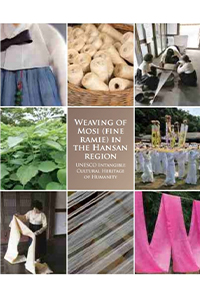International Cooperation
K-Heritage Series

- Title : Weaving of Mosi (fine ramie) in the Hansan region
- Publisher : Korea Heritage Agency (Korea Cultural Heritage Foundation)
- Written by : Jang Kyung-hee, Yoon Yang-no, Jeong Seong-mi
- Publication Date : 2023. 11. 10.
- Pages : 178
- Size : 163*200mm
- Price : Not for Sale
- ISBN : 978-89-6433-458-4
Book Description
This book, published in 2023, is part of the K-Heritage series and covers Weaving of Mosi (fine ramie) in the Hansan region, which was inscribed on the UNESCO Representative List of the Intangible Cultural Heritage of Humanity in 2011.
Hansan mosi is a textile representing the “beauty of the Korean people” that has been loved by Koreans for more than 1,500 years, and mosi clothes express Korea’s unique elegance and gracefulness, and play a role in connecting the past and the present. Weaving of Mosi in Hansan region, which has traditionally been inherited, was designated as a national intangible cultural property in 1967 due to its unique production process, characteristics, aesthetic value, and cultural meaning.
Table of Contents
- 1. Mosi with Korean sentiments
- 2. The intangible cultural value of weaving of Mosi in the Hansan region and the Hansan Ramie Fabric Cultural Festival
Ⅱ. The origin and history of weaving of Mosi in the Hansan region
- 1. The origin of weaving of Mosi in the Hansan region
- 2. Changes in weaving techniques of Hansan Mosi
- 3. Hansan Mosi markets in memories
Ⅲ. The production of Hansan Mosi and transmission of weaving of Mosi in the Hansan region
- 1. Collecting ramie grass and making taemosi
- 2. Splitting taemosi and connecting mosi fibers
- 3. Mosi nalgi and mosi maegi
- 4. Weaving and measuring the length of ramie cloth
- 5. The transmission of weaving of Mosi in the Hansan region
Ⅳ. The value and characteristics of the intangible heritage of Hansan Mosi weaving
- 1. Hansan Mosi and its long history
- 2. Hansan Mosi cloth representing Korean culture
- 3. The universality and validity of mosi weaving as an intangible heritage of humankind
- 4. Changes in sociocultural meaning and cultural identity
- 5. Excellent craftsmanship and sincerity
- 6. The beauty and artistry of traditional techniques and expressions
Ⅴ. Conclusion: The sustainability of weaving of Mosi in the Hansan region







